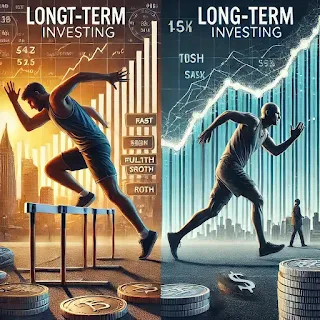Long-Term vs. Short-Term Investing: Which One is Right for You?
Investing is one of the best ways to build wealth over time, but choosing the right investment strategy can be challenging. The two most common approaches are long-term investing and short-term investing. Both have their advantages and risks, and the right choice depends on your financial goals, risk tolerance, and investment timeline. Let’s explore both strategies to help you decide which is best for you.
What is Long-Term Investing?
Long-term investing involves holding assets for several years or even decades. The goal is to benefit from market growth and compounding returns over time. This strategy is often associated with retirement accounts, index funds, blue-chip stocks, and real estate investments.
Advantages of Long-Term Investing:
Compounding Returns: Earnings from investments can generate additional earnings over time.
Lower Risk of Market Fluctuations: Long-term investors can ride out market volatility and benefit from overall economic growth.
Tax Benefits: Capital gains taxes are generally lower for long-term investments.
Less Stress: Requires less frequent monitoring and trading.
Disadvantages of Long-Term Investing:
Illiquidity: Money is tied up for a longer period.
Slower Gains: It may take years to see significant returns.
Market Downturns: While temporary, economic downturns can impact long-term holdings.
What is Short-Term Investing?
Short-term investing focuses on quick gains, usually within a few months or years. This strategy includes day trading, swing trading, and investing in volatile assets like cryptocurrencies or high-growth stocks.
Advantages of Short-Term Investing:
Quick Profits: Investors can capitalize on market trends and short-term price movements.
Liquidity: Funds are more readily available for other investments or expenses.
More Control: Frequent trading allows investors to react to market changes.
Disadvantages of Short-Term Investing:
Higher Risk: Market volatility can lead to significant losses.
Increased Taxes: Short-term capital gains are taxed at higher rates.
Time-Consuming: Requires constant monitoring, research, and active decision-making.
Which Strategy is Right for You?
The choice between long-term and short-term investing depends on several factors:
Your Financial Goals: If you’re saving for retirement or a child’s education, long-term investing is ideal. If you need quick profits for a short-term goal, short-term investing may work.
Risk Tolerance: If you can handle market volatility and frequent trading, short-term investing could be suitable. If you prefer stability, long-term investing is a better fit.
Time Commitment: Short-term investing requires active participation, while long-term investing is more passive.
Final Thoughts
Both long-term and short-term investing have their place in a well-balanced financial strategy. Many successful investors use a combination of both to maximize their returns while managing risk. Understanding your financial objectives, risk tolerance, and investment horizon will help you determine the best approach for you.





Comments
Post a Comment